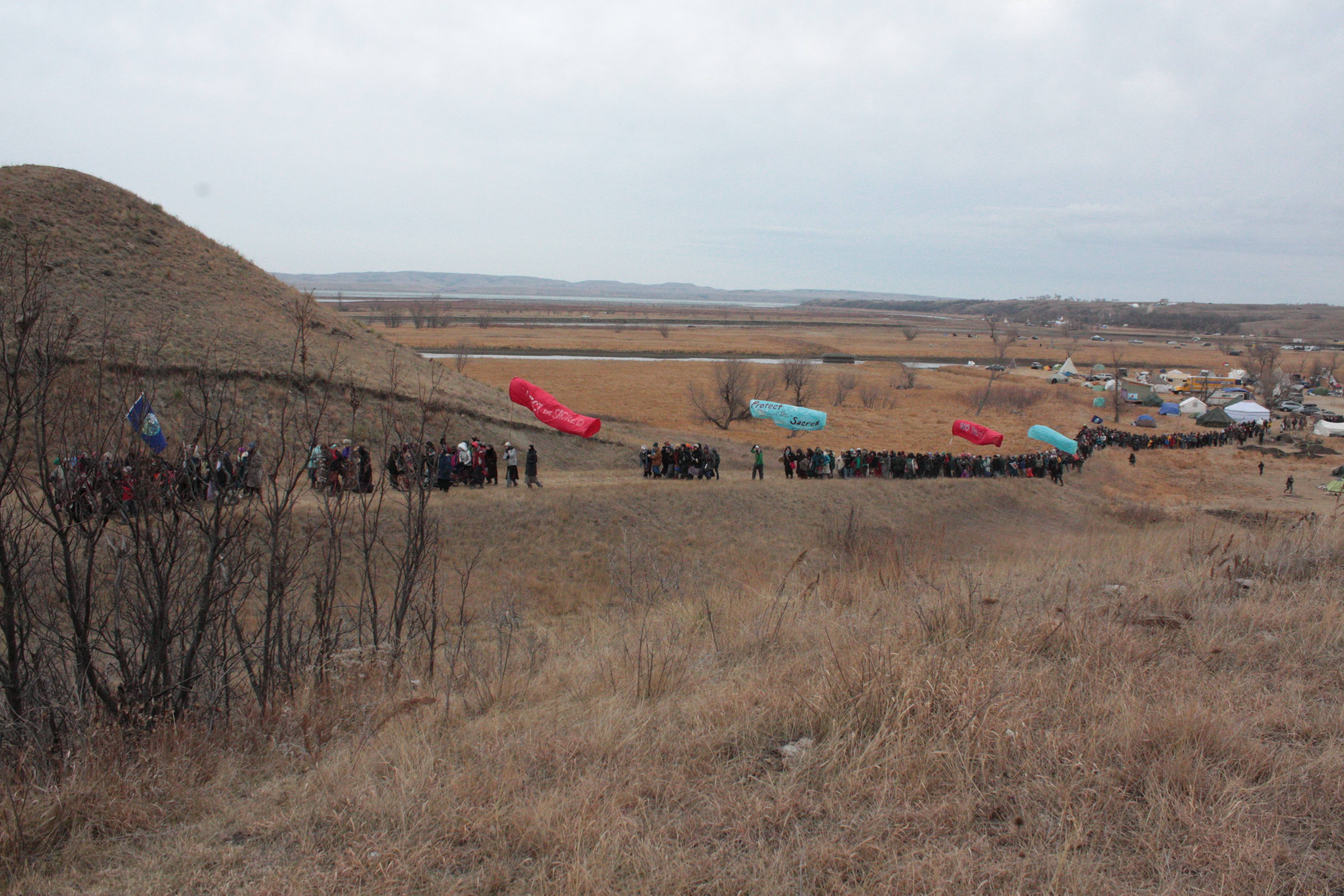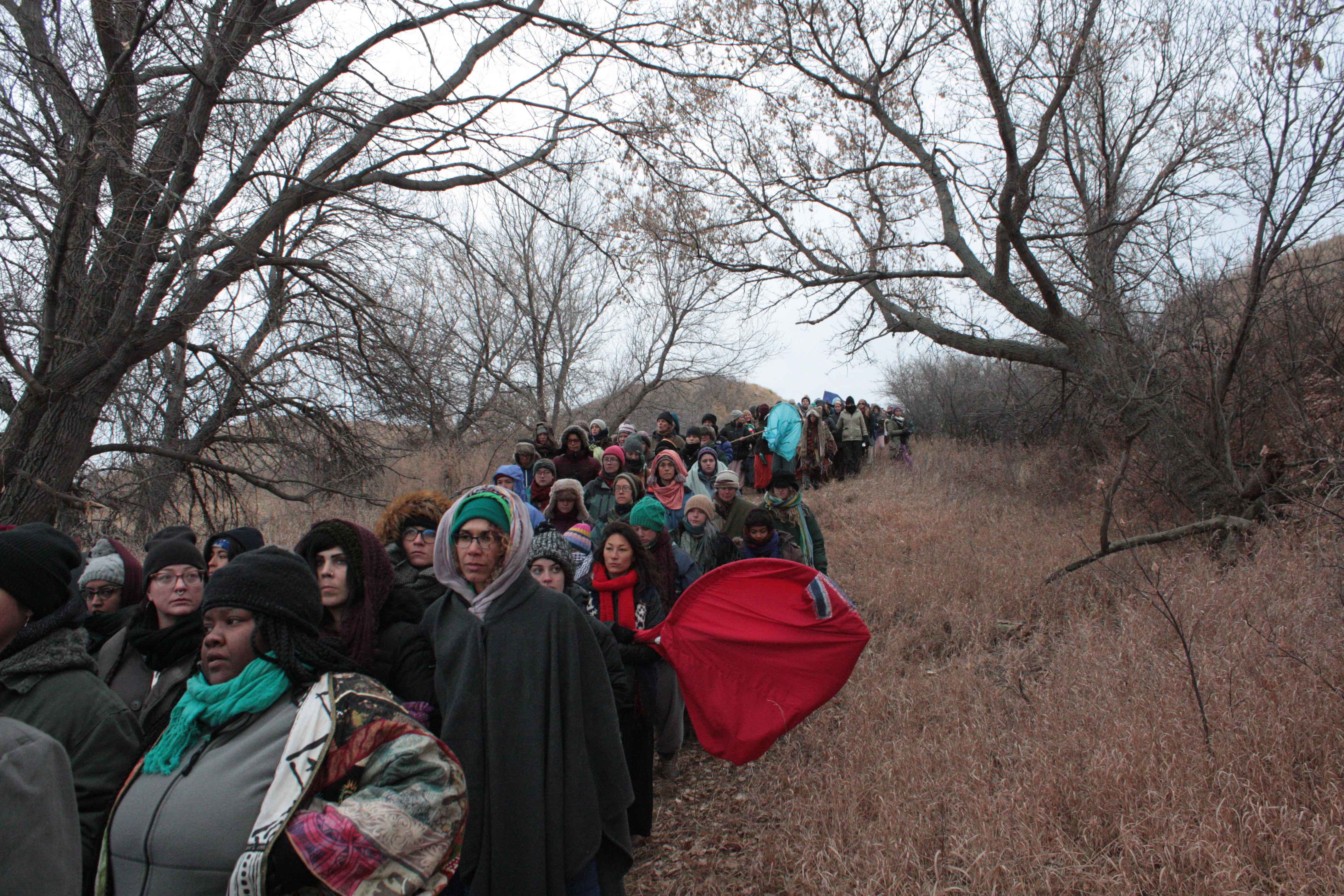On the Sunday of Thanksgiving weekend, hundreds of women marched arm-in-arm in silence from the Standing Rock Indian Reservation, in North Dakota, to the front lines of the resistance against the Dakota Access Pipeline, where teargas-soaked clothes still cover the ground.They came face-to-face with 50 police wearing riot gear and body cameras who eyed them from behind a razor wire and concrete barrier.The demonstration occurred a week after police deployed water cannons, tear gas and rubber bullets on protesters, who call themselves water protectors. In that crackdown, a man went into cardiac arrest, and a woman nearly lost her arm.This time, there was dialogue, and peace. “I pray that the water will be saved and that you join us,” one woman called through the barbed wire, as surveillance drones and a small plane flew low overhead.The protectors fear the $3.8-billion pipeline, which is slated to pump crude oil from North Dakota to Illinois, will poison the water supply near the reservation and disturb sacred burial grounds.
“I pray that the water will be saved and that you join us,” one woman called through the barbed wire, as surveillance drones and a small plane flew low overhead.The protectors fear the $3.8-billion pipeline, which is slated to pump crude oil from North Dakota to Illinois, will poison the water supply near the reservation and disturb sacred burial grounds. LaDonna Brave Bull Allard, who started the Standing Rock resistance, appealed to police for peace.“My father served as a police officer all of my life,” Brave Bull Allard told the four officers who faced them on the other side. “I understand the police officer and the respect for the police officer. I understand loyalty, honesty. I understand what a police officer stands for. I’m hoping and praying that you do too. That your job is to protect the people. As a child I rode in my father’s police car as we went to help the people, not hurt the people.”
LaDonna Brave Bull Allard, who started the Standing Rock resistance, appealed to police for peace.“My father served as a police officer all of my life,” Brave Bull Allard told the four officers who faced them on the other side. “I understand the police officer and the respect for the police officer. I understand loyalty, honesty. I understand what a police officer stands for. I’m hoping and praying that you do too. That your job is to protect the people. As a child I rode in my father’s police car as we went to help the people, not hurt the people.” The front line is a waist-height concrete barrier topped with eight-foot-high coils of razor wire. Police built the barrier across a bridge on Highway 1806, preventing all traffic in and out of the nearest town, Bismarck.The women knelt and prayed at the barrier. Then they asked to pour water that people had brought to Standing Rock from all over the world into the river. The police commander allowed them to walk over the grass down to the now-frozen river.
The front line is a waist-height concrete barrier topped with eight-foot-high coils of razor wire. Police built the barrier across a bridge on Highway 1806, preventing all traffic in and out of the nearest town, Bismarck.The women knelt and prayed at the barrier. Then they asked to pour water that people had brought to Standing Rock from all over the world into the river. The police commander allowed them to walk over the grass down to the now-frozen river. As winter nears, concerns over the safety of the thousands of people camped near the Standing Rock reservation have come front and centre. The Army Corps of Engineers issued a letter days ago, warning that it would close the federal land being used for the main camp on Dec. 5 due to safety concerns — namely that emergency vehicles cannot access the camp, and the harsh North Dakota winter is coming. In reaction, Chairman Dave Archambault II offered a 50-acre plot of nearby tribe land for the protectors to move to for the winter. But protectors on Corps-controlled land say they’re not moving, and are building wooden structures for winter — something police have warned them not to do.On Sunday, Reuters reported that the Army Corps issued a statement that it had “no plans for forcible removal” of the protesters, and that anyone who remained risked receiving citations.“The Army Corps of Engineers is seeking a peaceful and orderly transition to a safer location,” the statement said. “This will reduce the risk of harm to people in the encampments caused (by) the harsh North Dakota winter conditions.”Amid the tension, 1,500 veterans have promised to arrive before Dec. 5 to support the camp. But at the end of the Thanksgiving weekend, hundreds left the camp, leaving the question of what comes next hanging in the chilly air.
As winter nears, concerns over the safety of the thousands of people camped near the Standing Rock reservation have come front and centre. The Army Corps of Engineers issued a letter days ago, warning that it would close the federal land being used for the main camp on Dec. 5 due to safety concerns — namely that emergency vehicles cannot access the camp, and the harsh North Dakota winter is coming. In reaction, Chairman Dave Archambault II offered a 50-acre plot of nearby tribe land for the protectors to move to for the winter. But protectors on Corps-controlled land say they’re not moving, and are building wooden structures for winter — something police have warned them not to do.On Sunday, Reuters reported that the Army Corps issued a statement that it had “no plans for forcible removal” of the protesters, and that anyone who remained risked receiving citations.“The Army Corps of Engineers is seeking a peaceful and orderly transition to a safer location,” the statement said. “This will reduce the risk of harm to people in the encampments caused (by) the harsh North Dakota winter conditions.”Amid the tension, 1,500 veterans have promised to arrive before Dec. 5 to support the camp. But at the end of the Thanksgiving weekend, hundreds left the camp, leaving the question of what comes next hanging in the chilly air.
Advertisement



Advertisement
